Documents: Go to download!
User Manual
- User Manual - (English, French, Spanish)
- Installation Instruction - (English)
- Feature Sheet - (English)
- Warranty - (English)
- Energy Guide - (English)
- Dimension Guide - (English)
- PARTS AND FEATURES
- REFRIGERATOR USE
- REFRIGERATOR CARE
- TROUBLESHOOTING
Table of contents
Owner's Guide Refrigerator
PARTS AND FEATURES

What’s New Behind the Doors?
Your KitchenAid ® French door bottom-mount refrigerator comes equipped with various innovative storage and energy efficient features.
Energy and Normal Operating Sounds
Your new French door bottom-mount refrigerator has been designed with a linear compressor to optimize energy efficiency and better regulate temperatures to match cooling demand. You may notice that it operates differently than your previously owned refrigerator. It is normal for the high-efficiency compressor to run for extended periods of time at varying speeds in order to consume only the energy necessary for optimum efficiency. In addition, during various stages of the cooling cycle, you may hear normal operating sounds that are unfamiliar to you.
In-Door-Ice ® Ice Dispensing System
The ice maker and ice storage bin are located in the door for easy access to filtered ice while freeing up valuable shelf space inside.
Dual Evaporator
The refrigerator and freezer compartments have separate evaporators to provide fresh food and frozen food with optimal storage climates: cool and humid in the fresh food, cold and dry in the freezer, no mixing of air between the compartments to reduce the transfer of food odors and tastes from refrigerator, and allow freezer air to remain dry to control frost and reduce freezer burn.
Air Filter
An air filter is 15 times more powerful than baking soda at reducing common food odors inside the refrigerator. Replace your air filter every 6 months for maximum odor reduction.
Produce Preserver
Ethylene is a natural gas produced by fruits and vegetables to promote ripening. The Produce Preserver absorbs ethylene to delay the over-ripening of fresh produce. As a result, certain produce items will stay fresh longer.
EveryDrop ® Water Filter
EveryDrop ® water filters are NSF ®† Certified to reduce most contaminants, including chlorine taste and odor, lead, pesticides, and trace amounts of pharmaceuticals. EveryDrop ® brand filters are the only filters tested and certified for your refrigerator system. Replace your EveryDrop ® filter every 6 months for maximum contaminant reduction.
Water Dispenser with Measured Fill
The Measured Fill feature allows you to dispense a desired amount of filtered water in handy increments 8, 16, or 24 oz.
Water Dispenser with Favorite Fill
The Favorite Fill feature allows you to save 2 custom presets that can be programmed for favorite items that are frequently filled like a coffee pot or a water bottle.
Slide-Away Split Shelf
This shelf features a versatile design that allows three-quarters of the shelf to retract to accommodate taller items, up to 16.75 inches. This flexibility helps maximize storage space and optimize organization.
Removable Door Bins
Door bins that can be easily removed from the metal finish base they sit on, making them ideal for carrying condiments or items from refrigerator to table. The bins are dishwasher safe for easy cleaning.
FreshSeal™ Dairy Bin
A dedicated dairy bin with the FreshSeal™ gasket to help extend the freshness and preserve the flavor of butter and other dairy items.
FreshSeal™ Crispers
These upgraded crisper drawers use a gasket seal to maintain the ideal temperature and humidity levels to keep produce fresh longer. These drawers also feature premium soft-close glides that provide the best extension for easy access and maximum visibility to your produce items.
Pull-Out Tray
The tray fully extends for easy access and visibility. The tray also features soft self-close glides that provide effortless movement, even when fully loaded. The tray is removable, making cleaning easy.
Herb Storage Bin
This is a cylinder with FreshSeal™ to keep sensitive items like herbs fresh longer. The container allows water to be added to keep stems wet without covering leaves. It can be placed anywhere in the refrigerator and accommodates tall items like parsley, cilantro, and rosemary in addition to herbs like oregano, thyme, and mint.
Under Shelf Storage (on some models)
Utilizes typically empty space beneath the shelf to create a prep zone ideal for dough, desserts, casseroles, or marinating meats. The slide-out pan is oven and dishwasher safe and easily transitions from fridge to oven.
Adjustable Shelves on Flipper System
Shelves that can be adjusted up or down easily with the flip of a lever, allowing them to be adjusted without having to unload them. The shelves are easy to clean and let you use the whole shelf edge to edge for full visibility and accessibility.
Temp Control Pantry
Four temperature presets are available on the interior control to keep items at the optimal temperature. You can choose from meat/fish, cold drinks, deli/cheese, and wine. Pantry slides opens effortlessly, even when fully loaded, with soft, self-close glides and features the best extension in freestanding refrigeration.
3-Tier Freezer Drawer with Extend-Freeze™ Setting
A drawer system that organizes items on 3 levels making them easier to store and find. The lower drawer includes a divider. There’s also an in-door pizza pocket, a pull-out drawer for smaller items and third level glass shelf for small, flat items. The Extend-Freeze™ setting takes the entire freezer to its coldest setting to help reduce freezer burn and extend the life of frozen items.
Fingerprint-Resistant Steel and Black Stainless Steel (on some models)
A specialized coating for stainless steel that resists smudges, fingerprints, and water marks. It is easy to clean with just water and a towel.
LED Lighting
There is bright LED strip lighting for maximum illumination. LED lights do not require replacement.
Door Alarm
A helpful alarm sounds when the refrigerator door or freezer drawer is left ajar.
Power Outage Indicator
If the power should go out while you are away from home, this indicator will let you know that the refrigerator has been without power.
REFRIGERATOR USE
Opening and Closing Doors
There are 2 refrigerator compartment doors. The doors can be opened and closed either separately or together. There is a vertically hinged seal on the left refrigerator door.
- When the left-side door is opened, the hinged seal automatically folds inward so that it is out of the way.
- When both doors are closed, the hinged seal automatically forms a seal between the 2 doors.
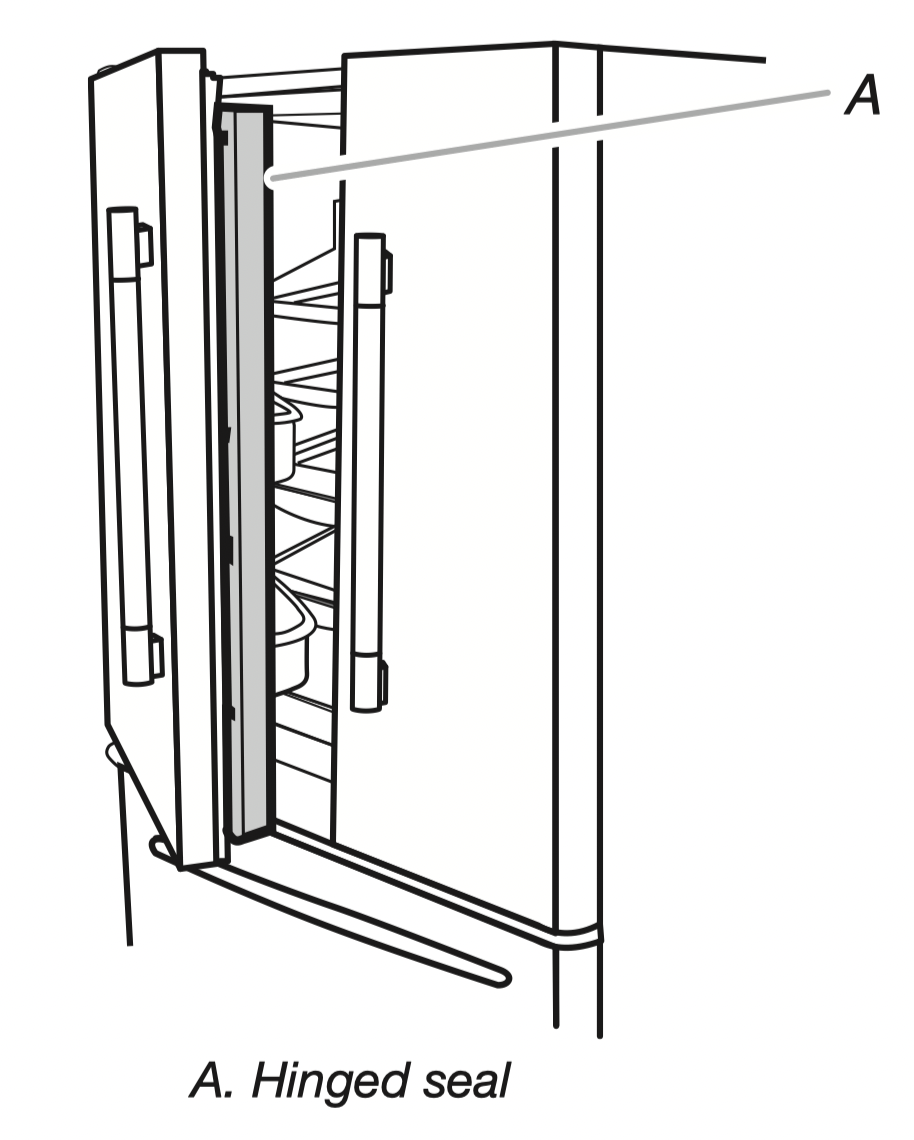
The refrigerator compartment door switch is located in the top left and right hinge cover.
- The door switch uses magnet to sense door opening/closing.
- Ensure there are no magnet or electronic devices (Speaker, CoolVox® , etc) within 3 inches of the hinge cap.
NOTE: The light and internal user interface (UI) will not turn on if the door opening is not detected.
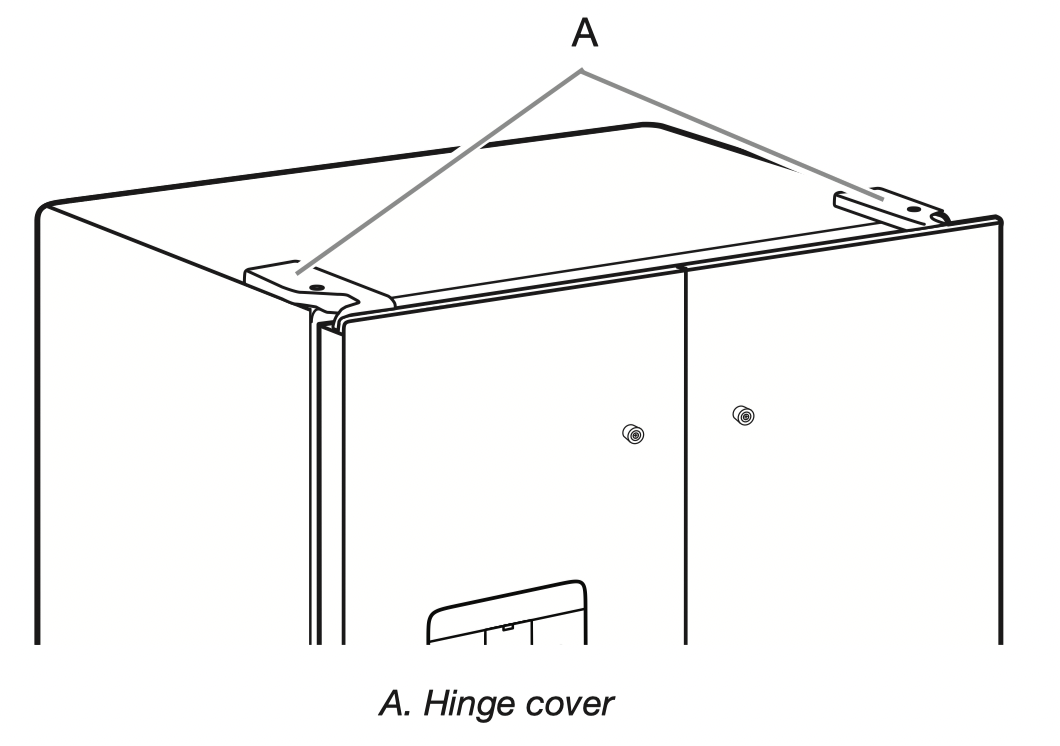
Using the Controls
The Temperature Control UI is located above the external dispenser and on the side of the left refrigerator door.

Viewing and Adjusting Temperature Set Points
For your convenience, your refrigerator and freezer controls are preset at the factory.
When you first install your refrigerator, make sure that the controls are still set to the recommended set points. The factory recommended set points are 37°F (3°C) for the refrigerator and 0°F (-18°C) for the freezer.
IMPORTANT:
- Wait 24 hours before you put food into the refrigerator. If you add food before the refrigerator has cooled completely, your food may spoil.
NOTE: Adjusting the set points to a colder-thanrecommended setting will not cool the compartments any faster. - If the temperature is too warm or too cold in the refrigerator or freezer, first check the air vents to be sure they are not blocked before adjusting the controls.
- The recommended settings should be correct for normal household use. The controls are set correctly when milk or juice is as cold as you like and when ice cream is firm.
NOTE: Areas such as a garage, basement, or porch may have higher humidity or extreme temperatures. You may need to adjust the temperature away from the recommended settings to accommodate for these conditions. - Wait at least 24 hours between adjustments. Recheck the temperatures before other adjustments are made.
View Temperature Set Points
- Touch [—]/[+] for Refrigerator or [—]/[+] for Freezer and toggle through temperature set points.
NOTE: To view temperature in degrees Celsius, touch and hold the [°F/°C] button for 3 seconds and the temperature display will change. To return to Fahrenheit, touch and hold the [°F/°C] for 3 seconds and the temperature display will change.
To activate Temperature mode for Drawer, touch DRAWER and toggle through 4 optional temperature settings: Meats • Fish, Cold Drinks, Deli • Cheese, and Wine. The display will show the temperature set point of the selected setting for the Drawer.
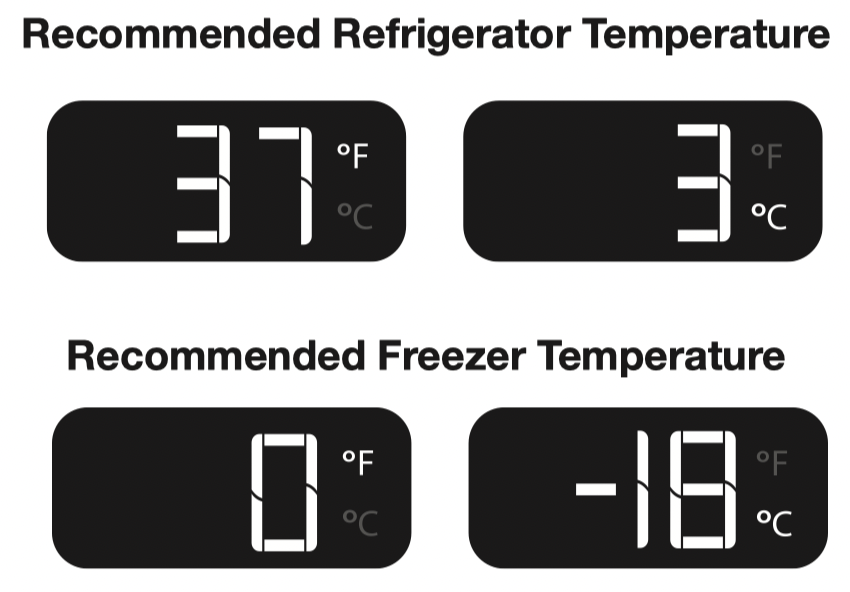
Adjust Temperature Set Points
Refrigerator set-point range: 33°F to 45°F (1°C to 7°C)
Freezer set point range: -6°F to 5°F (-22°C to -15°C)
- Touch [—]/[+] to adjust the Refrigerator zone. The display will show the temperature set point of the selected compartment as shown.
- When the temperature in is the range of Extend-Freeze™, the display will light up. Extend-Freeze™ is activated at the coldest Freezer set point.
When adjusting temperature set points, use the following chart as a guide:

Extend-Freeze™
This feature acts on the most-relevant storage parameters that must be controlled to minimize moisture migration from frozen food. This in turn reduces the freezer burn occurrence.
To turn on the Extend-Freeze™ feature, toggle to the coldest Freezer temperature set point.
To turn off the Extend-Freeze™ feature, toggle from the coldest freezer set point to any other temperature.
Max Cool
The Max Cool feature assists with periods of high refrigerator use, full grocery loads, or temporarily warm room temperatures.
- To turn on the Max Cool feature, press the Max Cool button. When the button is pressed, the icon will blink 3 times and appear on the display screen.
- To manually turn off the Max Cool feature, press the Max Cool button and the display will blink 3 times and turn off. The Max Cool feature will remain ON for 24 hours unless manually turned off. Adjusting the refrigerator temperature will automatically turn off the Max Cool feature.
NOTE: Setting the freezer to a colder temperature may make some foods, such as ice cream, harder.
Max Ice
The Max Ice feature assists with increasing the cooling for the freezer compartment in order to increase ice production.
- To turn on or off the Max Ice feature, press the Max Ice button. When the button is pressed to turn the feature on, the icon will blink 3 times and appear on the display screen.
- To manually turn off the Max Ice feature, press the Max Ice button and the display will blink 3 times and turn off. The Max Ice feature will remain ON for 24 hours unless manually turned off. Adjusting the freezer temperature will automatically turn off the Max Ice feature.
NOTE: Setting the freezer to a colder temperature may make some foods, such as ice cream, harder.
Water Filter Reset
Displays the status of the water filter. To reset the water filter, press MAX ICE and MAX COOL for 3 seconds. After countdown, the Good icon will blink 3 times and remain lit.
NOTE: The water filter status lights on the internal controls will let you know when to change your water filter.
- ORDER FILTER (Yellow) — Order a replacement water filter.
- REPLACE FILTER (Red) — Replace the water filter. While you are dispensing water, Replace Filter icon will flash constantly from beginning to the end of dispensing. After 14 days without replacing the Water Filter, the Replace Filter icon will blink 7 times and an alert tone will sound 3 times, at the end of dispensing. See “Water Filtration System” section.
NOTE: REPLACE FILTER will remain illuminated if a filter reset is not done. - RESET FILTER — Touch MAX ICE and MAX COOL at the same time on the temperature control display for 3 seconds to reset water filter. The display will do a 3-second countdown and then flash the icon and play a tone.
Energy Saver
Your refrigerator will turn off the vertical mullion heater and dispenser heater when Energy Saver is enabled.
- To turn Energy Saver on, press and hold the Energy Saver button for 3 seconds. The Energy Saver icon will blink 3 times and then remain lit as shown.
IMPORTANT: When Energy Saver is enabled and the LED is ON, the dispenser heater and vertical mullion heater will be turned off. - Press and hold ENERGY SAVER for 3 seconds again to turn the heaters back on.
Sound On/Off
The Sound button allows the customer to turn the sound on and off.
- To turn on the Sound feature, press the Sound button. When the button is pressed, the Sound icon will blink 3 times and appear on the display screen.
- To manually turn off the Sound feature, press the Sound button and the display will blink 3 times and turn off.
Power Outage
The Power Outage indicator lets you know if the power supply to the refrigerator has been OFF and the freezer temperature has risen.
The control panel display will read “Power Outage” and an alert tone will sound 3 times. Touch any button to stop the tone and turn off the Power Outage icon.
Once the power outage has been confirmed, “Power Outage,” will disappear.
Showroom Mode
This mode is used when the refrigerator is on display in a retail store or if you want to turn the cooling off and deactivates all other functions except interior lighting). Showroom mode can be used when going on vacation, see “Vacation and Moving Care” section for proper steps on leaving your refrigerator in this mode for long periods of time.
If you turn on Showroom mode, the word “Showroom” will light up on the display. Enter or Exit Showroom mode by pressing and holding °F/°C and DRAWER at the same time for 3 seconds.
NOTE: Empty ice maker if refrigerator is going to be turned off for an extended period of time.
Sabbath Mode
Sabbath mode is designed to have all the benefits of saving even more energy, yet maintaining food freshness. The freezer and refrigerator user set points remain unchanged while in this mode. If you unintentionally turn on Sabbath mode, the word “Sabbath” will light up on the display. Enter and exit Sabbath mode by pressing and holding °F/°C and SOUND at the same time for 3 seconds.
NOTE: You will be unable to dispense or change temperature set points in Sabbath mode. Your interior lighting and control panels will all be inactive in Sabbath mode.
External Dispenser Controls
The Dispenser UI is located above the external dispenser of the refrigerator.

IMPORTANT: The display screen on the dispenser control panel will turn off automatically and enter “sleep” mode when the control buttons and dispenser paddles have not been used for 2 minutes or more. Touch any control button to reactivate the display screen.
Additional Features
Door Ajar Alarm
The Door Ajar Alarm feature sounds an alarm when the refrigerator door(s) or freezer drawer is open for 5 minutes and cooling is turned on. The alarm will repeat every 2 minutes. Close all doors and drawer to turn it off.
NOTE: To mute the audible alarm while keeping the doors open, such as while cleaning the inside of the refrigerator, touch any button on the control panel. The alarm sound will be temporarily turned off, but the Door Ajar icon will still be displayed on the dispenser control panel.
Lighting the Refrigerator
The refrigerator has an interior light that comes on any time the door is opened.
NOTE: The light is an LED which does not need to be replaced. If the LED does not illuminate when the door is opened, call Service to replace the light. See “Assistance or Service” in “Warranty” section for contact information.
Water and Ice Dispensers
IMPORTANT:
- Allow 3 hours for the refrigerator to cool down and chill water.
- Allow 24 hours to produce the first batch of ice. Discard the first 3 batches of ice produced.
- The dispensing system will not operate if the left-hand refrigerator door is open.

Flush the Water System
Air in the water dispensing system can cause the water dispenser to drip. After connecting the refrigerator to a water source or replacing the water filter, flush the water system.
Flushing the water dispensing system forces air from the water line and filter and prepares the water filter for use. Additional flushing may be required in some households.
NOTE: As air is cleared from the system, water may spurt out of the dispenser.
- Using a sturdy container, depress and hold the water dispenser paddle for 5 seconds.
- Release the dispenser paddle for 5 seconds. Repeat steps 1 and 2 until water begins to flow.
- Once water begins to flow, continue depressing and releasing the dispenser pad (5 seconds on, 5 seconds off) until a total of 3 gal (12 L) has been dispensed.
Calibrate Measured Fill
Household water pressure may affect the accuracy of the Measured Fill feature. So, for optimum performance of your water dispenser, you must first calibrate Measured Fill.
IMPORTANT:
- Flush the water system before calibrating Measured Fill.
- For best results, calibration should be performed when water is not being used in the house.
- Place a sturdy measuring cup (1-cup [237 mL] size) on the dispenser tray centered in front of the ice/water dispenser paddle.
NOTE: Depending on your model, a measuring cup may be provided.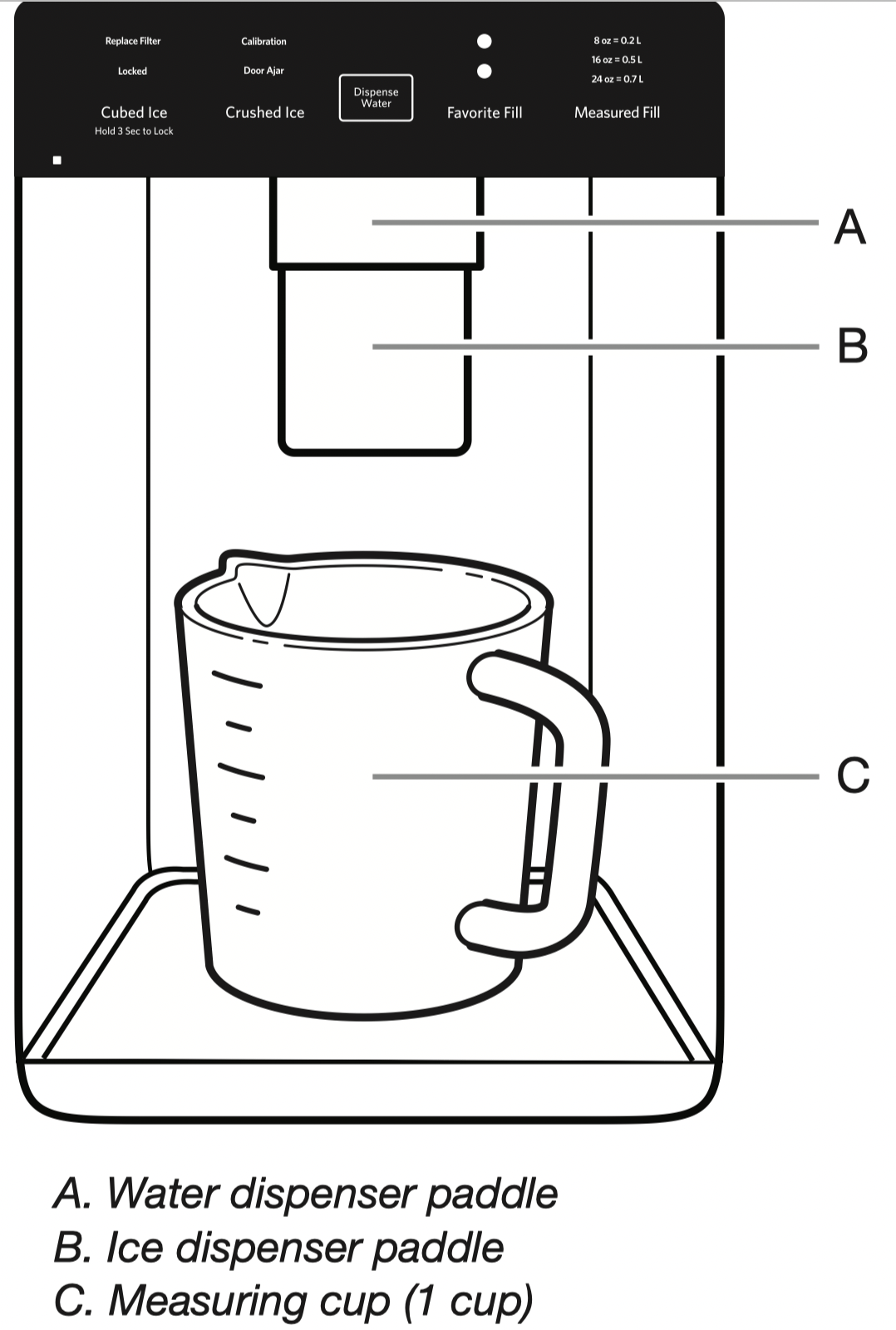
Ensure that you do not have any Measured Fill preset selected. - Touch and hold the Measured Fill button for 3 seconds to enter into Calibration mode. The Calibration and Measured Fill icons will illuminate and remain lit while the Measured Fill feature is being calibrated.
NOTE: You may touch MEASURED FILL to exit at any time in Calibration mode. The Calibration icon will disappear and the display will return to the Home screen. - Press and hold the water dispenser paddle, as needed, to dispense water to the 1-cup fill line in the measuring cup.
NOTE: If overfilling or spilling occurs, discard the water and restart the calibration process. - When 1 cup of water has been correctly dispensed into the measuring cup, touch MEASURED FILL to confirm the calibration.
- When Measured Fill calibration has been confirmed, the Calibration icon will disappear and the display will return to the home screen.
Save Favorite Fill
Household water pressure may affect the accuracy of the Favorite Fill feature. So, for optimum performance of your water dispenser, you must first calibrate Measured Fill. (See Measured Fill section).
NOTE: Water will not be dispensed using the Favorite Fill feature unless your preferred Favorite Fill amount is saved first.
IMPORTANT:
- Flush the water system before Favorite Fill.
- For best results, calibration should be performed when water is not being used in the house.
- Place a preferred-size cup on the dispenser tray centered in front of the ice/water dispenser paddle.
- Select either Favorite 1 or Favorite 2, and then touch and hold the Favorite Fill button for 3 seconds to enter into Saving mode. The Favorite Fill icon will illuminate and remain lit while the Favorite Fill feature is being saved. NOTE: You may touch FAVORITE FILL to exit at any time in Saving mode and the display will return to the Home screen.
- Press and hold the water dispenser paddle, as needed, to dispense water to the preferred-size cup. NOTE: If overfilling or spilling occurs, discard the water and restart the saving process.
- When the preferred amount of water has been correctly dispensed into the cup, touch the Favorite Fill button to confirm the favorite amount.
- When Favorite Fill amount has been confirmed, the display will return to the home screen.
Dispensing
Touch CUBED ICE or CRUSHED ICE for your ice selection.
NOTES:
- For crushed ice, cubes are crushed before being dispensed. This may cause a slight delay when dispensing crushed ice. Noise from the ice crusher is normal and pieces of ice may vary in size.
- When changing from crushed to cubed, a few ounces of crushed ice will be dispensed along with the first cubes.
Dispensing Water
IMPORTANT:
- Dispense at least 1 qt (1 L) of water every week to maintain a fresh supply.
- If the flow of water from the dispenser decreases, it could be caused by low water pressure.
- With the water filter removed, dispense 1 cup (237 mL) of water. If 1 cup (237 mL) of water is dispensed in 8 seconds or less, the water pressure to the refrigerator meets the minimum requirement.
- If it takes longer than 8 seconds to dispense 1 cup (237 mL) of water, the water pressure to the refrigerator is lower than recommended. See “Water Supply Requirements” and “Troubleshooting” sections for suggestions.
To Dispense Water — Standard:
- Press a sturdy glass against the water dispenser paddle.
- Remove the glass to stop dispensing.
NOTE: The Dispense Water button does not enable standard dispensing. It only functions in Measured Fill mode.
To Dispense Water — Measured Fill:
Measured Fill allows you to dispense a specified amount of water with the touch of a few buttons.
- Put a sturdy glass under waterspout. Touch MEASURED FILL to activate.
NOTE: The amount of water you select will be dispensed. Make sure the container can hold the entire volume. If ice is in the container, you may need to adjust your selection. - Touch MEASURED FILL to turn on, then touch to select 8 oz (0.2 L), 16 oz (0.5 L), or 24 oz (0.7 L). Touch the fourth time to exit Measured Fill display.
- Touch DISPENSE WATER (center button) or press paddle and the selected amount of water will be dispensed.
NOTES:
The Measured Fill dispenser will automatically time out after 1 minute of inactivity.
You can refill several glasses with the same measurement by continuing to touch DISPENSE WATER (center button) after each glass fill.
Measured Fill options are listed in the following chart:
NOTE: Most coffee cups (commonly 4 to 6 oz [118 to 177 mL] per cup) are not the same size as a measuring cup (8 oz [237 mL]). You may need to recalibrate Measured Fill to underfill or to avoid unintentionally overfilling coffee cups. - Dispense water.
NOTE: While dispensing water, the flow of water will automatically stop once the desired volume has been dispensed.
Press a sturdy glass against the dispenser paddle below the waterspout.
OR
Place the glass below the waterspout and touch DISPENSE WATER for hands-free dispensing. - To pause dispensing before the selected volume has been dispensed, touch DISPENSE WATER a second time or touch the water dispenser paddle. Touch DISPENSE WATER or paddle again to resume dispensing remaining amount.
NOTE: If you stop dispensing before the desired volume has been dispensed, the display will turn off after 1 minute. If you have not resumed by then, it will reset back to the original amount. - To select a new volume or start dispensing the same volume again, you must first finish dispensing the selected volume or turn off the Measured Fill feature (either by waiting 1 minute so it will automatically turn off or by touching CUBED ICE or CRUSHED ICE to manually turn it off), and then select Measured Fill again.
To Dispense Water — Favorite Fill:
Favorite Fill allows you to dispense a preferred amount of water with the touch of a few buttons.
- Put a sturdy glass under waterspout. Touch FAVORITE FILL to activate.
NOTE: The amount of water you select will be dispensed. Make sure the container can hold the entire volume. If ice is in the container, you may need to adjust your selection. - Touch FAVORITE FILL to turn on, then touch to select Favorite 1 or Favorite 2. Touch the third time to exit Favorite Fill display.
- Touch DISPENSE WATER (center button) or press paddle and the selected amount of water will be dispensed.
NOTES:
The Favorite Fill dispenser will automatically time out after 1 minute of inactivity.
You can refill several glasses with the same measurement by continuing to touch DISPENSE WATER (center button) after each glass fill. - Dispense water.
NOTE: While dispensing water, the flow of water will automatically stop once the desired volume has been dispensed.
Press a sturdy glass against the dispenser paddle below the waterspout.
OR
Place the glass below the waterspout and touch DISPENSE WATER for hands-free dispensing. - To pause dispensing before the selected volume has been dispensed, touch DISPENSE WATER a second time or touch the water dispenser paddle. Touch DISPENSE WATER or paddle again to resume dispensing remaining amount.
NOTE: If you stop dispensing before the desired volume has been dispensed, the display will turn off after 1 minute. If you have not resumed by then, it will reset back to the original amount. - To select a new volume or start dispensing the same volume again, you must first finish dispensing the selected volume or turn off the Favorite Fill feature (either by waiting 1 minute so it will automatically turn off or by touching CUBED ICE or CRUSHED ICE to manually turn it off), and then select Favorite Fill again.
The Ice Dispenser
IMPORTANT:
- If the ice cubes are hollow or have an irregular shape, it could be because of low water pressure. See “Water Supply Requirements” section.
- Ice travels from the ice storage bin through the dispenser chute to the dispenser. To turn off the ice maker, see “Ice Maker and Storage Bin” section.
- The dispenser may continue to make noise and ice may continue to dispense for several seconds after releasing the dispenser button or paddle.
To Clean the Ice Dispenser Chute:
Humidity causes ice to naturally clump together. Ice particles can build up until the ice dispenser chute becomes blocked.
If ice is not dispensed regularly, it may be necessary to empty the ice storage bin and clean the ice delivery chute, the ice storage bin, and the area beneath the storage bin every 2 weeks.
- If necessary, remove the ice clogging the storage bin and delivery chute using a plastic utensil.
- Clean the ice delivery chute and the bottom of the ice storage bin using a warm, damp cloth, and then dry thoroughly.
To Dispense Ice:
Paddle Dispensing
- Select the desired type of ice by pressing CUBED ICE or CRUSHED ICE.
WARNING - Cut Hazard
Use a sturdy glass when dispensing ice.
Failure to do so can result in cuts. - Press a sturdy glass against the dispenser paddle. Hold the glass close to the dispenser opening, so ice does not fall outside of the glass.
IMPORTANT: You do not need to apply a lot of pressure to the paddle to activate the ice dispenser. Pressing hard will not make the ice dispense faster or in greater quantities. - Remove the glass to stop dispensing.
NOTE: Ice may continue to dispense for several seconds after removing the glass from the dispenser paddle. The dispenser may continue to make noise for a few seconds after dispensing.
The Dispenser Drip Tray
The drip tray can be removed to carry to the sink to empty or clean.
- Lift up on the front edge of the tray and pull forward remove.
- The drip tray can also slide out to assist in Measured/Favorite Fill.
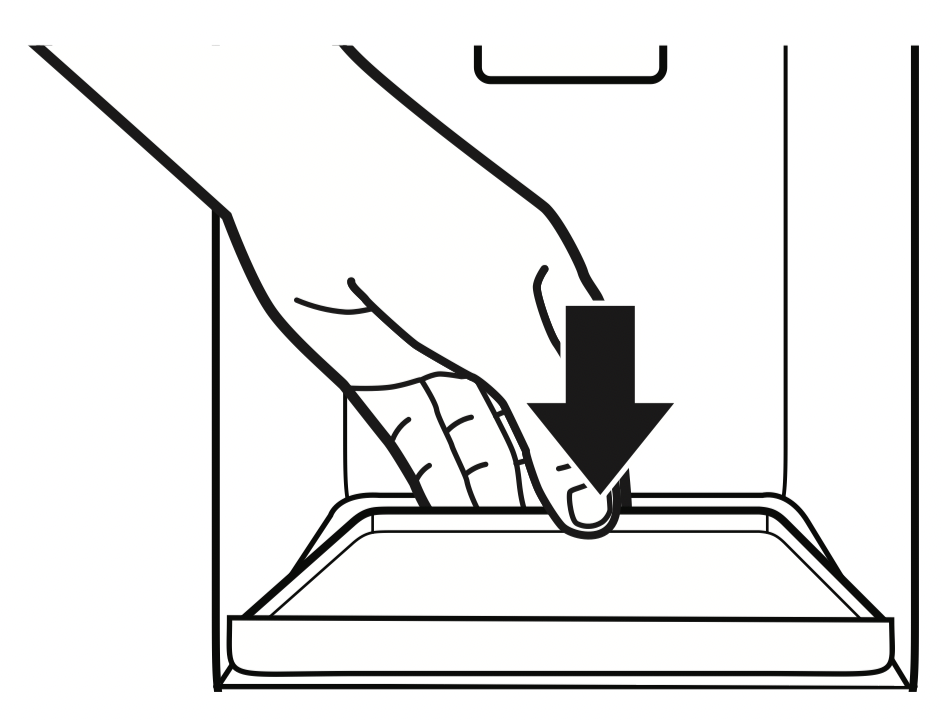
The Dispenser Light
- When you use the dispenser, the light will automatically turn on.
- The dispenser light also serves as an automatic nightlight. Once the ambient light in the room is reduced, the auto sensor will cause the dispenser light to illuminate.
The Dispenser Lock
The dispenser can be locked for easy cleaning or to avoid unintentional dispensing by small children and pets.
NOTE: The lock feature does not shut off power to the refrigerator or the dispenser light. It simply deactivates the controls and dispenser levers. To turn off the ice maker, see “Ice Maker and Storage Bin” section.
- Touch and hold CUBED ICE for 3 seconds to lock the dispenser.
- Touch and hold CUBED ICE for 3 seconds to unlock the dispenser.
- The display screen indicates when the dispenser is locked.
Ice Maker and Storage Bin
IMPORTANT: To avoid low ice production and poor quality ice, flush the water system before turning on the ice maker. See “Water Dispenser” section.
- Following installation, allow 24 hours to produce the first batch of ice. Discard the first 3 batches of ice produced. Allow 2 to 3 days to fill the ice storage bin.
- The quality of your ice will be only as good as the quality of the water supplied to your ice maker. Avoid connecting the ice maker to a softened water supply. Water softener chemicals (such as salt) can damage parts of the ice maker and lead to poor quality ice. If a softened water supply cannot be avoided, make sure the water softener is operating properly and is well-maintained.
- If the ice in the storage bin clumps together, break up ice using a plastic utensil and discard ice. Do not use anything sharp to break up the ice. This can cause damage to the ice bin and the dispenser mechanism.
- Do not store anything in the ice storage bin.
Ice Maker in the Refrigerator
The ice maker is located on the left door behind the bins. Ice cubes are ejected into the ice storage bin located on the left-hand refrigerator door.
Turn the Ice Maker On/Off
- Push up on the latch on the left-hand side of the ice compartment to open the door.
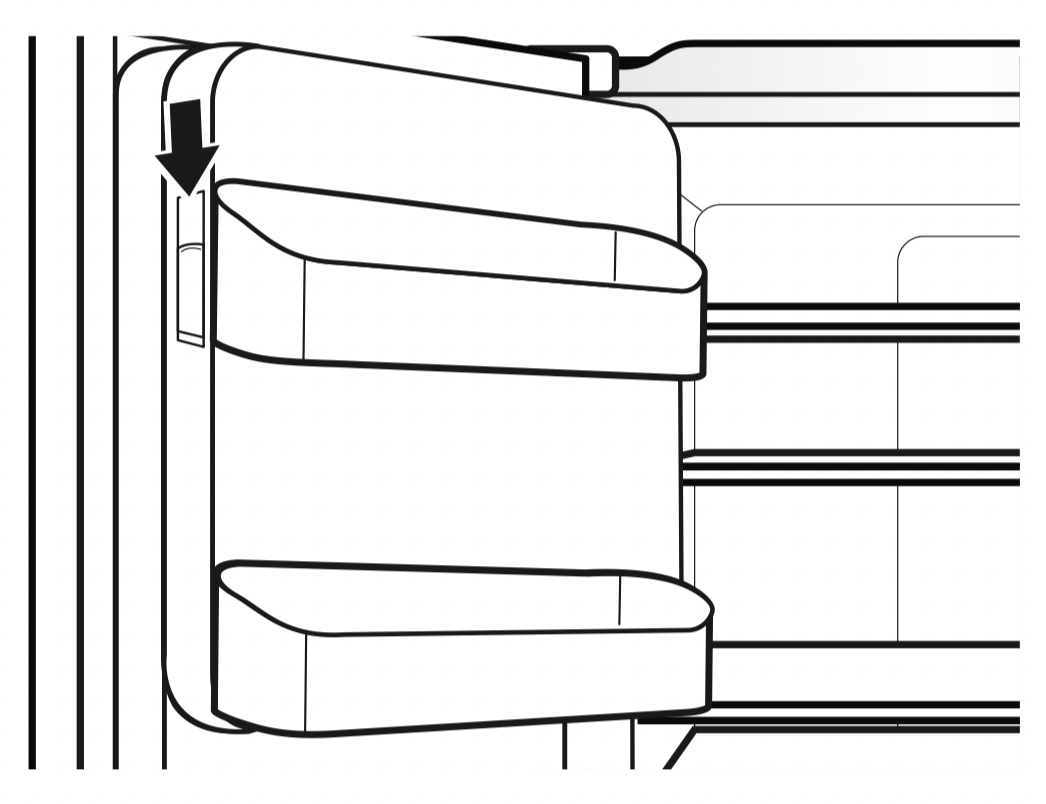
- Turn on the ice maker by moving position.
NOTES:
To manually turn off the ice maker, move the control to the Off (O) position.
Your ice maker has an automatic shutoff. The sensor will automatically stop ice production if the storage bin is full, if the door is open, or the storage bin is removed. The control will remain in the On (up) position.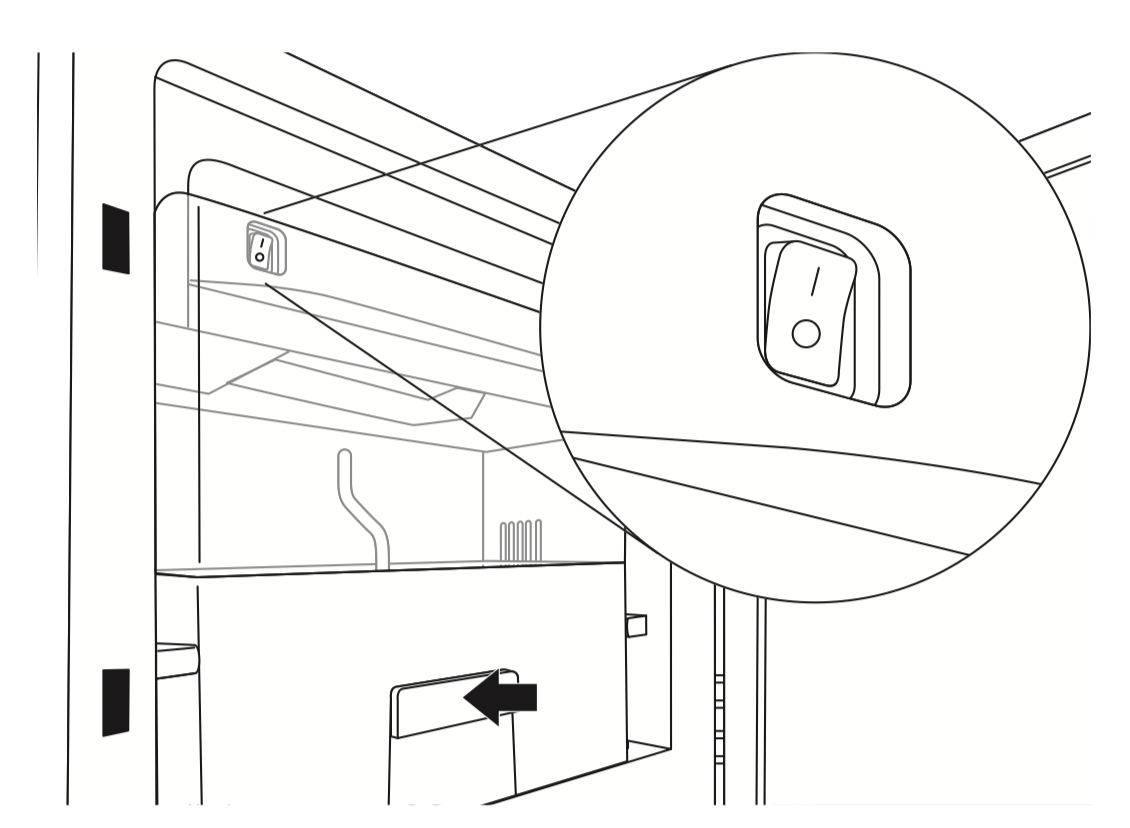
- Close the ice compartment door.
Remove and Replace the Ice Storage Bin
- Remove the ice storage bin by inserting your fingers into the hole at the base of the bin and pulling the latch to release the bin from the compartment. Lift the storage bin up and pull it straight out.
- Replace the storage bin inside the ice compartment and push down to make sure it is firmly in place.
Ice Production Rate
- The ice maker should produce approximately 3 lbs (1.4 kg) of ice per day under normal operation.
- To increase ice production, select the “Fast Ice” feature from the control panel. See “Using the Controls” section.
Shelves, Bins, and Drawers
Slide-Away Split Shelf
Some shelves will tuck away to create room for taller objects.
- To retract the front section of the shelf, push the adjustable portion of the shelf as far back as needed toward the rear of the refrigerator.
- Extend the front glass and front trim of the shelf by pulling the retracted portion of the shelf outward until it is fully extended.
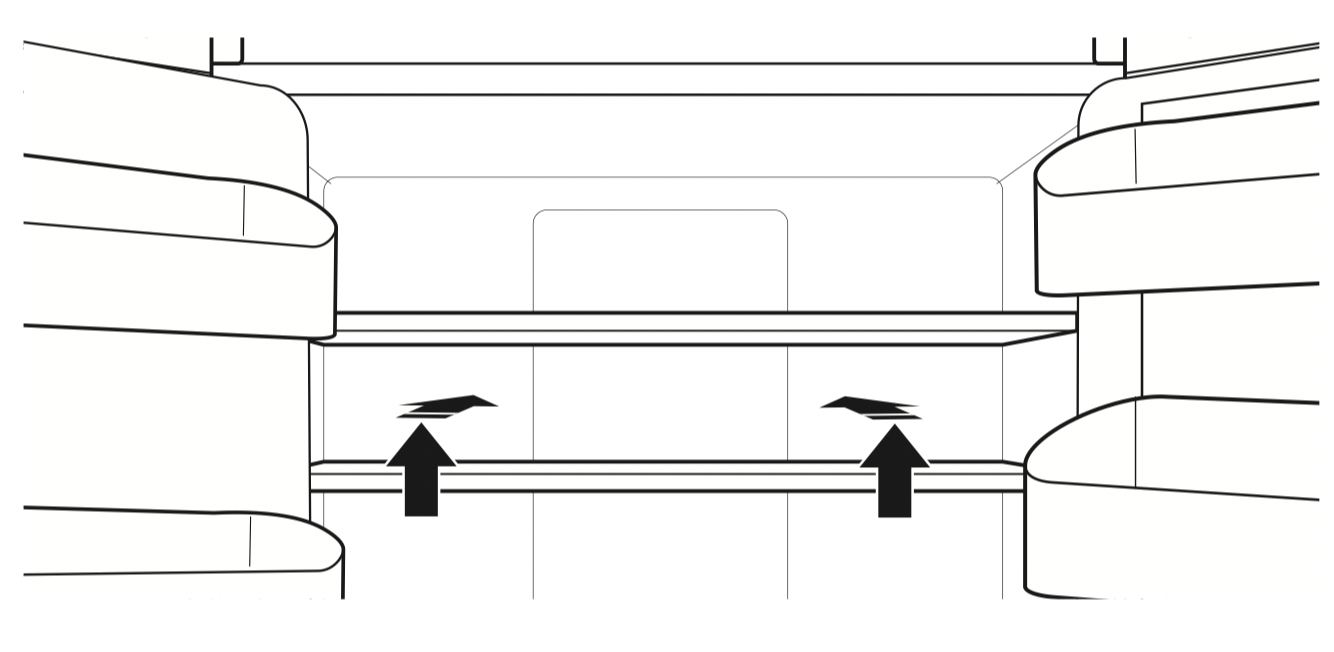
Wine Rack and/or Under Shelf Storage Pan
Under one shelf, there are brackets installed to the supports (one bracket on each support). The wine rack or under-shelf storage rests in these brackets.
To remove and replace the wine rack or pan:
- Remove the wine rack/pan by lifting it up off the brackets. Press the right-hand side of the rack inward until it is free of its bracket. Lower the right-hand side slightly and disengage the left-hand side from its bracket.
- Replace the wine rack/pan by inserting the left-hand side into its bracket. Press inward on the right-hand side until it will slide past the bracket edge and set it into its bracket.
NOTE: Under shelf storage pan utilizes typically empty space beneath the shelf to create a prep zone ideal for doughs, desserts, casseroles, or marinating meats. The slide-out pan is oven and dishwasher safe and easily transitions from fridge to oven.
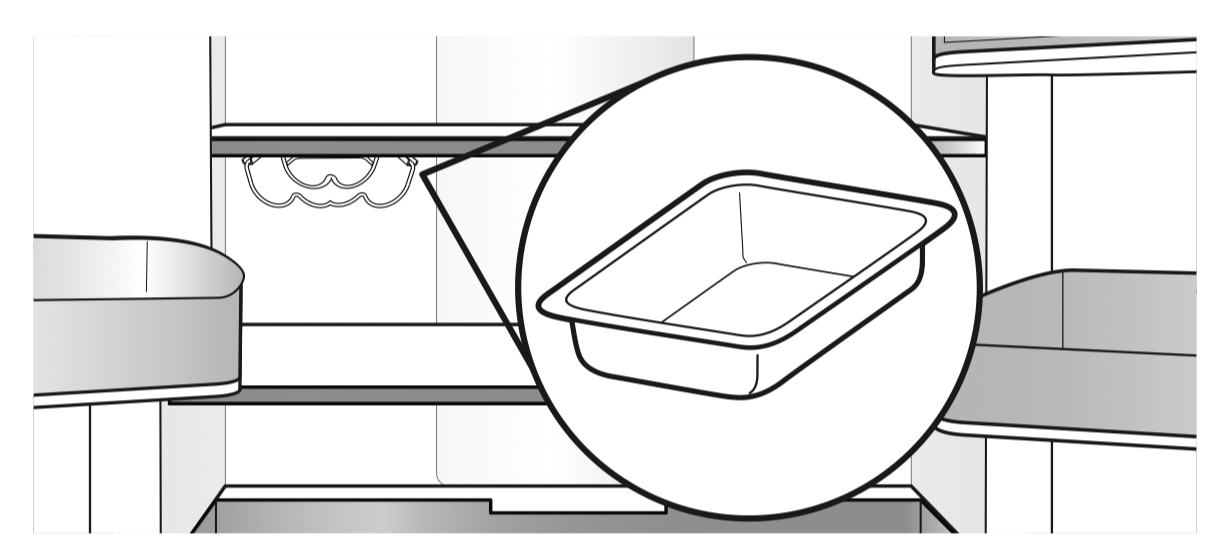
Important information to know about glass shelves and covers: Do not clean glass shelves or covers with warm water when they are cold. Shelves and covers may break if exposed to sudden temperature changes or impact, such as bumping. Tempered glass is designed to shatter into many small, pebble-size pieces. This is normal. Glass shelves and covers are heavy. Use both hands when removing them to avoid dropping.
Shelves and Shelf Frames
The shelves in your refrigerator are adjustable to meet your individual storage needs.
Storing similar food items together in your refrigerator and adjusting the shelves to fit different heights of items will make finding the exact item you want easier. It will also reduce the amount of time the refrigerator door is open and save energy.
Shelf Height Adjustment
Shelf height can be adjusted by changing the adjustable shelf mounts between their vertical and horizontal positions.
- Carefully lift the shelf off the shelf mounts and turn the flipper to the desired orientation.
- Repeat for remaining shelf mounts.
- Apply pressure to the top of the shelf to ensure the shelf is properly seated on the shelf mounts.
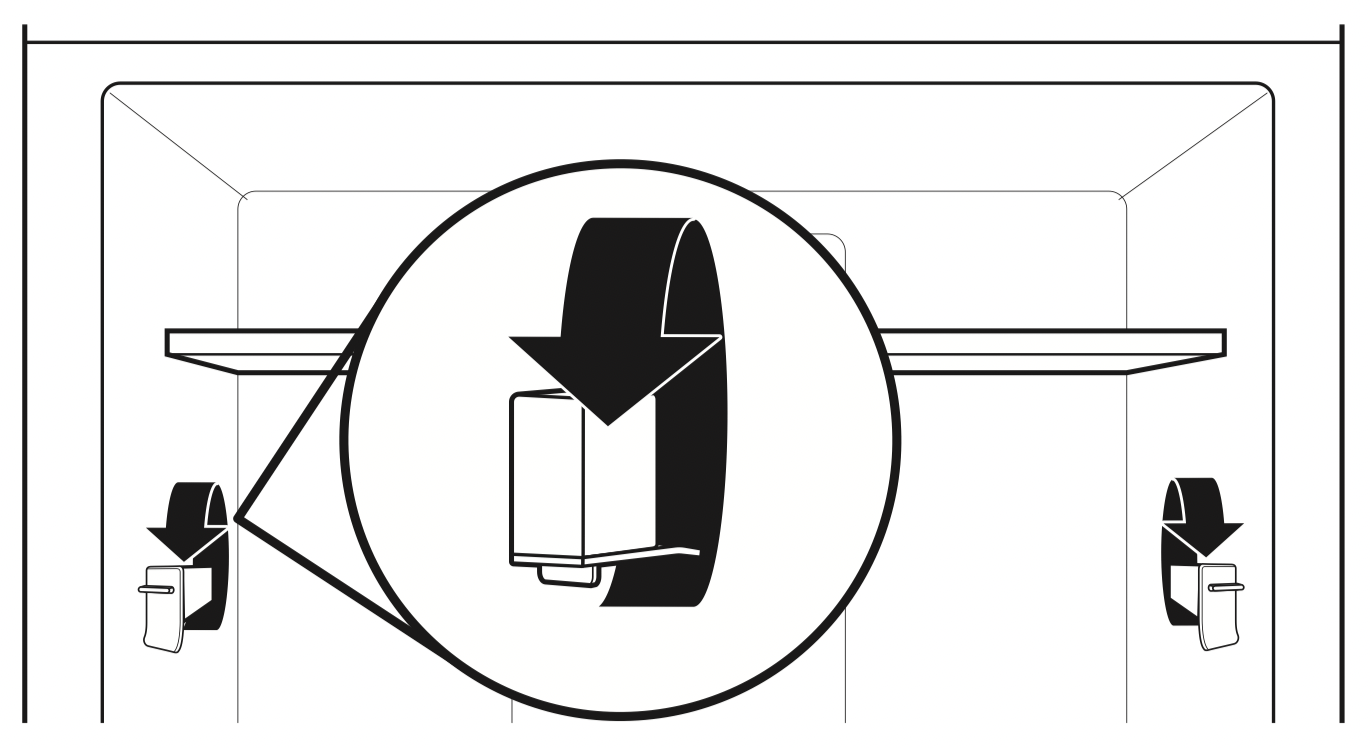
To remove and replace shelves:
- Make sure adjustable shelf mounts are in the lower position before removing shelves. Also doors will need to be open at a 90˚ angle. If open wider, it will make it harder to remove the shelves.
- Remove the middle shelf or top shelf by lifting it up and out of the shelf supports. Then pull the shelf forward and tilt down to a vertical position. Turn the shelf at an angle and pull out of the refrigerator.
NOTE: Remove middle shelf first before removing top shelf. Infinity slide glass shelves should be pushed back in. When tilted up, make sure glass does not slide to front. - Remove the bottom shelf by lifting it up and out of the shelf supports. Then pull the shelf forward and tilt up to a vertical position. Turn the shelf at an angle and pull out of the refrigerator.
- Replace the middle and top shelves by putting the shelf in the refrigerator at an angle with the shelf front down. Lift the front of the shelf up and slide in until rear shelf drops into the shelf supports. Lower the front of the shelf and make sure that the shelf is in position.
- Replace the bottom shelf by putting the shelf in the refrigerator at an angle with the shelf up. Lift the front of the shelf down and slide in until rear shelf drops into the shelf supports. Lower the front of the shelf and make sure that the shelf is in position.
Shelves with under-shelf lighting (on some models)
By moving LED lighting to a new spot under the shelves, this leading-edge technology improves interior refrigerator lighting and aids in locating storage items.
Pull-Out Tray
To remove and replace the pull-out tray:
- Pull the tray to the fully open position or when it stops.
- Lift up and out of gliders toward the front of the refrigerator.
- Replace the tray by placing it on the bottom tray guide and pushing it past the tray stop into position.
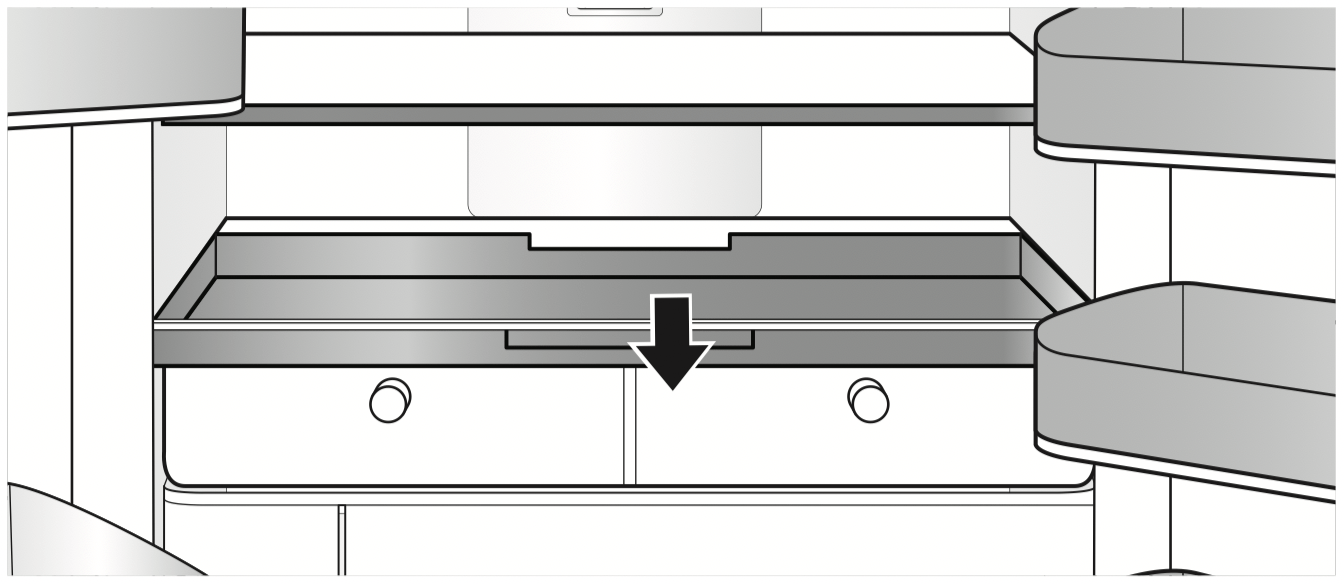
FreshSeal™ Crisper Drawers
These upgraded crisper drawers use a gasket seal to maintain the ideal temperature and humidity levels to keep produce fresh longer. These drawers also feature premium soft-close glides that provide the best extension for easy access and maximum visibility to your produce items.
To remove and replace the drawers:
- Grasp the handle at the bottom of the drawer and slide the drawer straight out to the stop. Lift the drawer off the bottom guide.
- Replace the drawer by placing it on the bottom drawer guide and pushing it past the drawer stop into position.
To remove the crispers cover (can remove only if platter pocket is removed first):
- Remove the platter pocket first.
- Holding the glass insert firmly with one hand, press up in center of glass insert until it rises above the plastic frame. Gently slide the glass insert forward to remove.
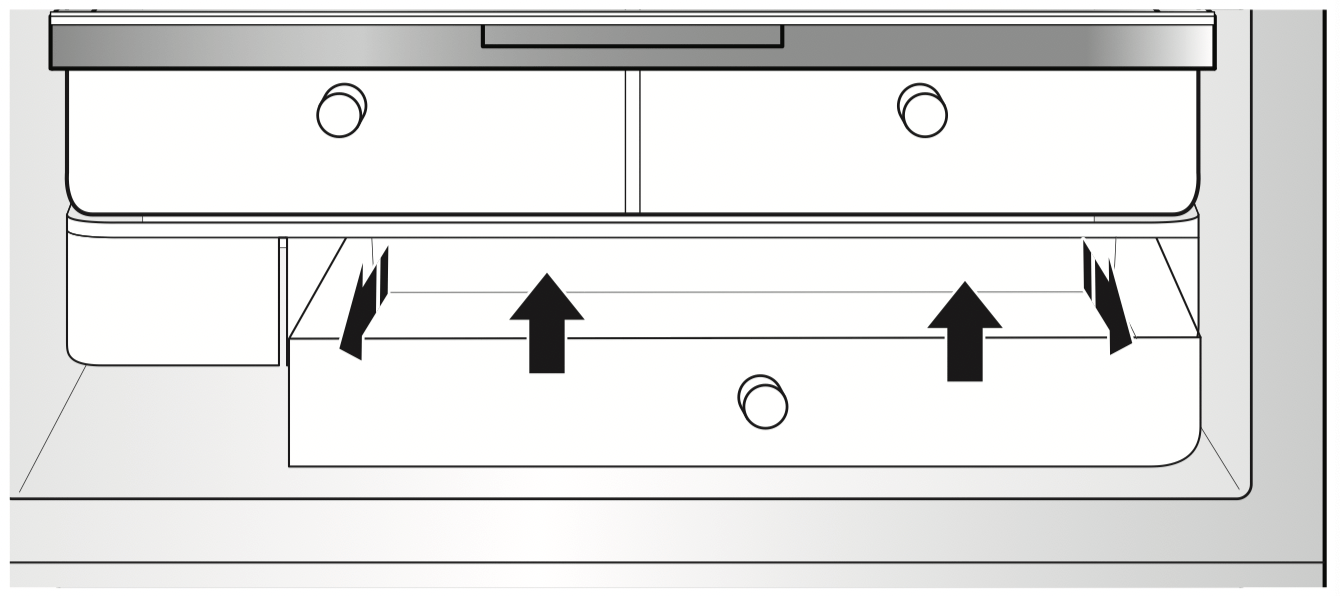
To replace crisper(s) cover(s):
- Remove the crisper pan, platter pocket, and crisper glass before removing the crisper.
- Fit back of cover frame into supports on side walls of the refrigerator and lower the front of the cover frame into place.
- Slide rear of glass insert into cover frame and lower front into place.
Refrigerator Door Bins
The bins on your refrigerator door are adjustable to meet your individual storage needs.

FreshSeal™ Herb Bin
This is a cylinder with a FreshSeal™ to keep sensitive items like herbs fresh longer. The container allows water to be added to keep stems wet without covering leaves. It can be placed anywhere in the refrigerator and accommodates tall items like parsley, cilantro, and rosemary in addition to herbs like oregano, thyme, and mint.
Freezer Drawers
Small Items Bin (on some models)
This drawer divider is not removable and is for small, delicate items. For storage flexibility, the drawer bin can move forward and back, allowing you to store larger items in one section of the freezer.
Pizza Pocket
Space at the front of the drawer allows vertical storage of additional pizza boxes.
Third Tier
This shelf is not removable. To allow access, the third tier is able to move backward, allowing access to items in the area below.
Ice Bin (on some models)
Ice storage for second ice maker.
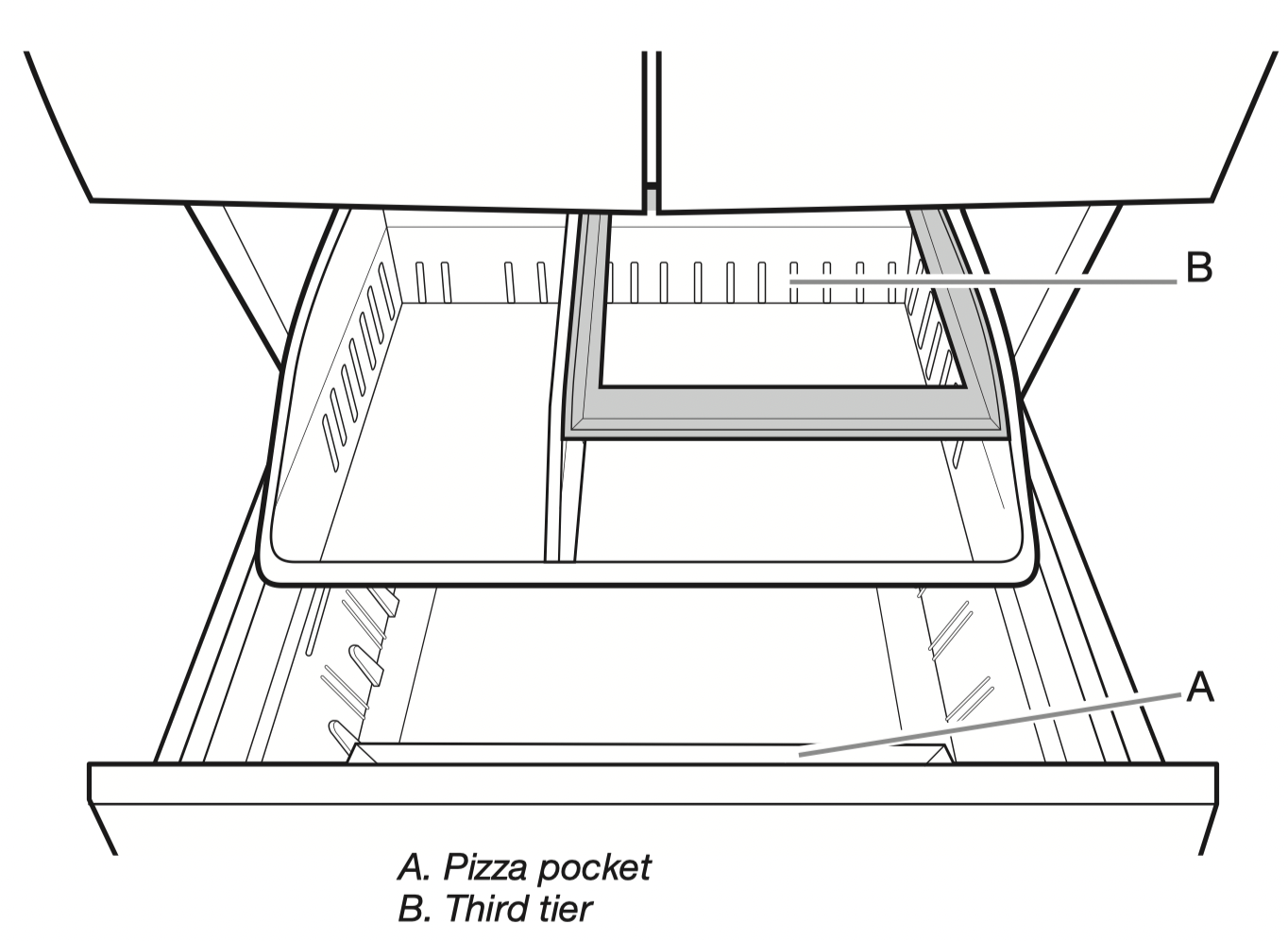
Audio Reference
Tone Assignment
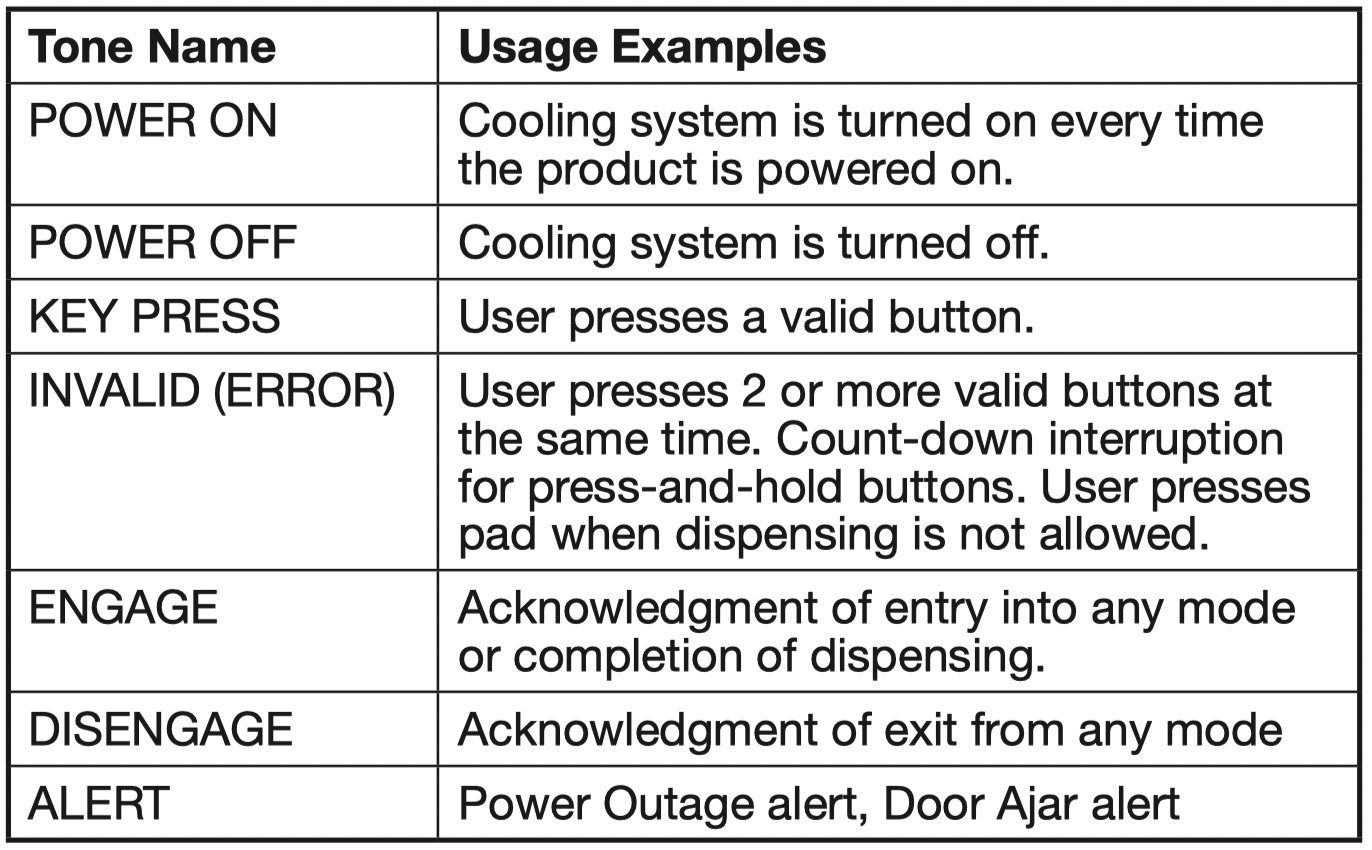
This table is for quick reference only. See corresponding sections for details. In case of inconsistency, section details will prevail.
REFRIGERATOR CARE
Cleaning
WARNING - Explosion Hazard
- Use nonflammable cleaner.
- Failure to do so can result in death, explosion, or fire.
Both the refrigerator and freezer sections defrost automatically. However, clean both sections about once a month to avoid buildup of odors. Wipe up spills immediately.
Exterior Cleaning
Please see the exterior cleaning information specific to your model.
Style 1 — Smooth Door
IMPORTANT: Damage to smooth finish due to improper use of cleaning products or using non-recommended cleaning products is not covered under the warranty. Sharp or blunt instruments will mark the finish.

NOTE: Paper towels scratch and may dull the clear coat of the painted door. To avoid possible damage, use only soft, clean clothes to polish and wipe the doors.
Style 2 — Stainless Steel
IMPORTANT:
- Use recommended stainless steel cleaners and cloths only. Damage to stainless steel finish due to improper use of cleaning products or using non-recommended cleaning products is not covered under the warranty.
- Avoid exposing stainless steel appliances to caustic or corrosive elements such as high-salt, high-moisture, or high-humidity environments. Damage due to exposure to these elements is not covered under the warranty.

Style 3 — Fingerprint - Resistant Stainless and Fingerprint - Resistant Black Stainless
- Avoid exposing stainless steel appliances to caustic or corrosive elements such as high-salt, high-moisture, or high-humidity environments. Damage due to exposure to these elements is not covered under the warranty.

NOTES:
- If unintentional contact does occur, clean plastic part with a sponge and mild detergent in warm water. Dry thoroughly with a soft cloth.
- Just because a cleaner is a liquid does not mean it is nonabrasive. Many liquid cleansers formulated to be gentle on tile and smooth surfaces still damage stainless steel.
- Citric acid permanently discolors stainless steel. To avoid damaging the finish of your stainless steel refrigerator:
Do not allow these substances to remain on the finish:
✘ Mustard
✘ Citrus-based sauces
✘ Tomato juice
✘ Citrus-based products
✘ Marinara sauce
Interior Cleaning
IMPORTANT: Refrigerator shelves with under-shelf, LED lighting are not dishwasher safe.
- Unplug refrigerator or disconnect power.
- Hand wash, rinse, and dry removable parts and interior surfaces thoroughly. Use a clean sponge or soft cloth and a mild detergent in warm water. NOTE: Do not use abrasive or harsh cleaners such as window sprays, scouring cleansers, flammable fluids, cleaning waxes, concentrated detergents, bleaches, or cleansers containing petroleum products on plastic parts, interior and door liners, or gaskets.
- Plug in refrigerator or reconnect power.
Condenser Cleaning
There is no need for routine condenser cleaning in normal home operating environments. If the environment is particularly greasy or dusty or there is significant pet traffic in the home, the condenser should be cleaned every 6 months to ensure maximum efficiency.
If you need to clean the condenser, please call for service.
Lights
The lights in both the refrigerator and freezer compartments are LEDs which do not need to be replaced. If the lights do not illuminate when the door or drawer is opened, call for assistance or service. In the U.S.A., call 1-800-253-1301. In Canada, call 1-800-807-6777.
Vacation and Moving Care
Vacations
If You Choose to Leave the Refrigerator On While You’re Away:
- Use up any perishables and freeze other items.
- If your refrigerator has an automatic ice maker and is connected to the household water supply, turn off the water supply to the refrigerator. Property damage can occur if the water supply is not turned off.
- If you have an automatic ice maker, turn off the ice maker. Press the switch to OFF for the door ice maker.
- Empty the ice bin.
If You Choose to Turn Off the Refrigerator Before You Leave:
NOTE: Put refrigerator in Showroom Mode while on Vacation. See “Using the Controls” section.
- Remove all food from the refrigerator.
- If your refrigerator has an automatic ice maker: Turn off the water supply to the ice maker at least 1 day ahead of time. When the last load of ice drops, press the switch to OFF for display to be unlit on the top inside of the refrigerator, depending on your model.
- Empty the ice bin.
- Turn off the temperature controls. See “Using the Controls” section.
- Clean refrigerator, wipe it, and dry well.
- Tape rubber or wood blocks to the tops of both doors to prop them open far enough for air to get in. This stops odor and mold from building up.
Moving
When you are moving your refrigerator to a new home, follow these steps to prepare it for the move.
- If your refrigerator has an automatic ice maker: Turn off the water supply to the ice maker at least 1 day ahead of time. Disconnect the water line from the back of the refrigerator. When the last load of ice drops, press the switch to OFF either on the ice maker or the control, depending on your model.
- Remove all food from the refrigerator and pack all frozen food in dry ice.
- Empty the ice bin.
- Unplug refrigerator.
- Clean, wipe, and dry thoroughly.
- Take out all removable parts, wrap them well, and tape them together so they don’t shift and rattle during the move.
- Depending on the model, raise the front of the refrigerator so it rolls more easily OR raise the leveling screws so they don’t scrape the floor. See “Adjust the Doors” or “Refrigerator Leveling and Door Closing” section.
- Tape the doors closed and tape the power cord to the back of the refrigerator.
When you get to your new home, put everything back and refer to the “Installation Instructions” section for preparation instructions. Also, if your refrigerator has an automatic ice maker, remember to reconnect the water supply to the refrigerator.
TROUBLESHOOTING
Refrigerator Operation
WARNING - Electrical Shock Hazard
- Plug into a grounded 3 prong outlet.
- Do not remove ground prong.
- Do not use an adapter.
- Do not use an extension cord.
- Failure to follow these instructions can result in death, fire, or electrical shock.
| If you experience | Possible Causes | Solution |
|---|---|---|
| The refrigerator will not operate. | Check electrical supply. | Plug the power cord into a grounded 3 prong outlet. |
| Do not use an extension cord. | ||
| Make sure there is power to the outlet. Plug in a lamp to see if the outlet is working. | ||
Reset a tripped circuit breaker. Replace any blown fuses. NOTE: If problems continue, contact an electrician. | ||
| Check controls. | Make sure the controls are turned on. See “Using the Controls” section. | |
| New installation | Allow 24 hours following installation for the refrigerator to cool completely. NOTE: Adjusting the temperature controls to the coldest setting will not cool either compartment more quickly. | |
| Refrigerator control is in Showroom mode (on some models). | If the refrigerator is in Showroom mode, cooling is turned off and “Showroom” will be illuminated on the control panel. See “Using the Controls” section for more information. | |
| The motor seems to run too much. | High-efficiency compressor and fans | Larger, more efficient refrigerators run longer at lower, more energy efficient speeds. |
| The room or outdoor temperature is hot. | It is normal for the refrigerator to work longer under these conditions. For optimum performance, place the refrigerator in an indoor, temperature-controlled environment. See “Location Requirements” section. | |
| A large amount of warm food has been recently added. | Warm food will cause the refrigerator to run longer until the air cools to the desired temperature. | |
| The door(s) are opened too frequently or for too long. | Warm air entering the refrigerator causes it to run more. Open the door less often. | |
| The refrigerator door or freezer drawer is ajar. | Make sure the refrigerator is level. See “Refrigerator Leveling and Door Closing” section. Keep food and containers from blocking the door. | |
| The refrigerator control is set too cold. | Adjust the refrigerator control to a less-cold setting until the refrigerator temperature is as desired. | |
| The door or drawer gasket is dirty, worn, or cracked. | Clean or change the gasket. Leaks in the door seal will cause the refrigerator to run longer in order to maintain desired temperatures. | |
| The lights do not work. | Your refrigerator is equipped with LED lighting which does not need to be replaced. | If there is power to the refrigerator and the lights do not illuminate when a door or drawer is opened, call for service or assistance. |
| Doors have been open longer than 10 minutes. | Close the doors and drawer to reset and open to resume lighted task. | |
| The door switch is not sensing the door opening. | Ensure there are no magnets or electronic devices within 3" (7.6 cm) of the hinge cover. | |
| The Temperature Control UI does not turn on | The door switch is not sensing the door opening. | Ensure there are no magnets or electronic devices within 3" (7.6 cm) of the hinge cover. |
Unusual Noise
| If you experience | Possible Causes | Solution |
|---|---|---|
| The refrigerator seems noisy. | The compressor in your new refrigerator regulates temperature more efficiently while using less energy and operates quietly. | Due to this reduction in operating noise, you may notice unfamiliar noises that are normal. |
| Sound of the compressor running longer than expected | High-efficiency compressor and fans | Larger, more-efficient refrigerators run longer at lower, more energy efficient speeds. |
| Pulsating/Whirring | Fans/compressor adjusting to optimize performance during normal compressor operation | This is normal. |
| Popping | Contraction/expansion of inside walls, especially during initial cooldown | This is normal. |
| Hissing/Dripping | Flow of refrigerant or flow of oil in the compressor | This is normal. |
| Vibration | The refrigerator may not be steady. | Adjust the leveling screws and lower the leveling foot firmly against the floor. See “Refrigerator Leveling and Door Closing” section. |
| Rattling/Banging | Movement of the water lines against the refrigerator cabinet or of items placed on top of the refrigerator cabinet | Move excess water line away from the refrigerator cabinet or fasten excess tubing to the cabinet. See “Connect the Water Supply” section or remove items from the top of the refrigerator. |
| Sizzling | Water dripping on the heater during Defrost cycle | This is normal. |
| Water running/Gurgling | May be heard when ice melts during the Defrost cycle and water runs into the drain pan | This is normal. |
| Buzzing and clicking | Heard when the water valve opens and closes to dispense water and/or fill the ice maker | If the refrigerator is connected to a water line, this is normal. If the refrigerator is not connected to a water line, turn off the ice maker. |
| Repetitive clicking | Dual evaporator valve regulating the cooling operation | You may hear rapid repetitive clicking sounds as the unit switches from cooling one compartment to cooling the other. This sound is normal. |
| Creaking/Cracking/ Grinding | May be heard as ice is being ejected from the ice maker mold. | This is normal. |
| Clatter | May be heard when the ice falls into the ice storage bin. | This is normal. |
Temperature and Moisture
| If you experience | Possible Causes | Solution |
|---|---|---|
| Temperature is too warm. | The refrigerator has just been installed. | Allow 24 hours following installation for the refrigerator to cool completely. |
| The controls are not set correctly for the surrounding conditions. | Adjust the controls a setting colder. Check the temperature in 24 hours.See “Using the Controls” section. | |
| The door(s) are opened often or not closed completely. Allows warm air to enter refrigerator. | Minimize door openings and keep doors fully closed. | |
| A large load of food was recently added. | Allow several hours for refrigerator to return to normal temperature. | |
| Temperature is too cold in the refrigerator/crisper. | The refrigerator air vent(s) are blocked. | If the air vent located in the middle rear of the refrigerator compartment is blocked by items placed directly in front of it, the refrigerator will get too cold. Move items away from the air vent. |
| The controls are not set correctly for the surrounding conditions. | Adjust the controls a setting warmer. Check the temperature in 24 hours. See “Using the Controls” section. | |
| The ice storage bin is not in the correct position. | See “Ice Maker and Ice Storage Bin” section. | |
| Temperature is too cold in the pantry drawer. | The control is not set correctly for the items stored in drawer. | Adjust the temperature setting. See “Using the Controls” in the “Refrigerator Use”section. |
There is interior moisture buildup. NOTE: Some moisture buildup is normal. | The room is humid. | A humid environment contributes to moisture buildup. |
| The door(s) are opened often or not closed completely. Allows humid air to enter the refrigerator. | Minimize door openings and close doors completely. | |
| The door(s) are blocked open. | Move food packages away from door. | |
| A bin or shelf is in the way. | Push bin or shelf back into the correct position. | |
| Storing liquid in open containers | This adds humidity to the refrigerator interior. Keep all containers tightly covered. | |
| There is frost/ice buildup in the freezer compartment. | The drawer is opened often or left open. | Minimize drawer openings and close drawer completely after use. |
| Poor door seal | Ensure door seals are making full contact with the refrigerator cabinet to allow for an adequate seal. | |
| Temperature controls are not set correctly. | See “Using the Controls” section for recommended temperature settings. |
Ice and Water
| If you experience | Possible Causes | Solution |
|---|---|---|
| The ice maker is not producing ice or is not producing enough ice. | The refrigerator is not connected to a water supply or the water supply shut-off valve is not turned on. | Connect refrigerator to water supply and turn water shut-off valve fully open. |
| There is a kink in the water source line. | A kink in the line can reduce water flow. Straighten the water source line. | |
| The ice maker is not turned on. | Make sure the ice maker is ON. See “Ice Maker and Ice Storage Bin” section. | |
| The refrigerator has just been installed. | Wait 24 hours after ice maker installation for ice production to begin. Wait 3 days for full ice production. | |
| The refrigerator door is not closed completely. | Close the door firmly. If it does not close completely, see “The doors will not close completely” in this table. | |
| A large amount of ice was recently removed. | Allow sufficient time for ice maker to produce more ice. See “IceMaker and Ice Storage Bin” section for ice production rates. | |
| The ice maker is not producing ice or is not producing enough ice.(cont.) | An ice cube is jammed in the ice maker. | Remove ice from ice maker with a plastic utensil. |
| A water filter is installed on the refrigerator. | Remove the water filter and operate the ice maker. If ice volume improves, then the filter may be clogged or incorrectly installed. Replace filter or reinstall it correctly. | |
| A reverse osmosis water filtration system is connected to the cold water supply. | This can decrease water pressure. See “Water Supply Requirements” section. | |
The ice cubes are hollow or small. NOTE: This is an indication of low water pressure. | The water shut-off valve is not fully open. | Turn the water shut-off valve to fully open. |
| There is a kink in the water source line. | A kink in the line can reduce water flow. Straighten the water source line. | |
| A water filter is installed on the refrigerator. | Remove filter and operate ice maker. If ice quality improves, then the filter may be clogged or incorrectly installed. Replace filter or reinstall it correctly. | |
| A reverse osmosis water filtration system is connected to the cold water supply. | This can decrease water pressure. See “Water Supply Requirements” section. | |
| Questions remain regarding water pressure. | Call a licensed, qualified plumber. | |
| Off-taste, odor, or gray color in the ice or water | Newly installed refrigerator requires flush of water system. | Flush the water system. See “Water and Ice Dispensers” section for water system flushing instructions. |
| Recently installed or replaced plumbing connections. New plumbing connections can cause discolored or off-flavored ice and water. | Discard the ice and wash the ice storage bin. Flush the water system with 3 gal. (12 L)of water. Allow 24 hours for the ice maker to make new ice and discard the first 3batches of ice produced. | |
| Using a water supply connection type other than recommended. | It is recommended to use copper tubing or KitchenAid ®supply line, Part Number8212547RP. See “Connect to Water Line” section. | |
| The ice has been stored too long. | Discard ice and wash ice storage bin. Allow 24 hours for ice maker to make new ice. | |
| The water has been stored too long. | Dispense at least 1 qt (1 L) of water per week to maintain a fresh supply. | |
| Odor from stored food has transferred to the ice. | Use airtight, moisture-proof packaging to store food. | |
| There are minerals (such as sulfur) in the water. | A water filter may need to be installed to remove the minerals. | |
| There is a water filter installed on the refrigerator. | Gray or dark discoloration in ice may indicate that the water filtration system needs additional flushing. Flush the water system after installing and before using a new water filter. See “Water and Ice Dispensers” section for water filter flushing instructions. | |
| The water filter needs to be replaced. | Replace the disposable water filter at least every 6 months or when indicated. See “Water Filtration System” section. | |
| The water and ice dispenser will not operate properly. | The refrigerator is not connected to a waters upply or the water supply shut-off valve is not turned on. | Connect the refrigerator to the water supply and turn the water shut-off valve fully open. |
| There is a kink in the water source line. | A kink in the water line can reduce water flow from the water dispenser and result in hollow or irregular shaped ice. Straighten the water source line. | |
| The refrigerator has just been installed. | Flush and fill the water system. See “Water and Ice Dispensers” section. | |
| The water pressure to the house is not at or above 35 psi (241 kPa). | The water pressure to the house determines the flow from the dispenser. See “WaterSupply Requirements” section. | |
| A reverse osmosis water filtration system is connected to the cold water supply. | A reverse osmosis water filtration system can decrease water pressure. See “Water Supply Requirements”section. | |
| The water filter may be clogged. | Remove the water filter and operate dispenser. If water flow increases, your filter is clogged and needs to be replaced. See “Water Filtration System” section. | |
| The water filter is installed incorrectly. | Remove the water filter and reinstall. See “Water Filtration System” section. | |
| The refrigerator door or freezer drawer is not closed completely. | Close the door or drawer firmly. If it does not close completely, see “The doors will not close completely”section. | |
| The refrigerator doors were recently removed. | Make sure the water dispenser wire/tube assembly has been properly reconnected at the top of the refrigerator door. See “Refrigerator Leveling and Door Closing” section. | |
| Ice is clogged in the ice storage bin or ice is blocking the ice delivery chute. | Remove the ice clogging the storage bin and delivery chute using a plastic utensil if necessary. Clean the ice delivery chute and the bottom of the ice storage bin using a warm, damp cloth, then dry both thoroughly. To avoid clogging and to maintain a fresh supply of ice, empty the storage bin and clean both the storage bin and delivery chute every 2 weeks. | |
| Ice bin is difficult to remove from door. | Ice level in bin may be high and uneven from normal ice production and augering of ice during dispensing. | Dispense 2-3 glasses of ice, then try removing the ice bin. |
| The ice dispenser jams while dispensing crushed ice. | Crushed ice is blocking the ice delivery chute. | Switch from crushed ice to cubed ice to clear the ice dispenser. Then switch back to crushed ice. |
Water is leaking or dripping from the dispenser system. NOTE: A few drops of water after dispensing are normal. | The glass was not held under the dispenser long enough. | Hold the glass under the dispenser 2 to 3 seconds after releasing the dispenser lever. |
Ice continues to flow from the dispenser. NOTE: A few cubes dispensed after releasing the dispenser lever is normal. | The glass was not held under the dispenser long enough. | Hold the glass under the dispenser 2 to 3 seconds after releasing the dispenser lever. |
| Water continues to drip from the dispenser beyond the first few drops. | The refrigerator has just been installed. | Flushing the water system removes air from the lines which causes the water dispenser to drip. Flush the water system. See “Water and Ice Dispensers” section. |
| The water filter was recently installed or replaced. | Flushing the water system removes air from the lines which causes the water dispenser to drip. Flush the water system. See “Water and Ice Dispensers” section. | |
| There may be a loose water connection. | Check for water in bottom of refrigerator compartment, hinge area, or by household connection in back of product. | |
| Water is leaking from the back of the refrigerator. | The water line connections were not fully tightened. | See “Connecting the Water” section. |
| Recently removed the doors and did not fully tighten waterline connection. | See “Refrigerator Leveling and Door Closing” section. | |
| Crushed or cubed ice misses the glass when dispensing ice. | The glass is not held close enough to where the ice exits the chute. | Hold the glass close to where the ice exits the chute. |
| Water from the dispenser is warm. | Water from the dispenser is chilled to 50°F (10°C). | This is normal. |
| The refrigerator has just been installed. | Allow 24 hours after installation for the water supply to cool completely. | |
| A large amount of water was recently dispensed. | Allow 3 hours for the water supply to cool completely. | |
| Water has not been recently dispensed. | The first glass of water may not be cool. Discard the first glass of water dispensed. | |
| The refrigerator is not connected to a cold water pipe. | Make sure the refrigerator is connected to a cold water pipe. See “Water Supply Requirements” section. |
Doors
WARNING - Explosion Hazard
- Use nonflammable cleaner.
- Failure to do so can result in death, explosion, or fire.
To view an animation showing how to adjust and align the doors, refer to the Product Help/FAQ section of the brand website and search for “Door Closing and Door Alignment.”
| If you experience | Possible Causes | Solution |
|---|---|---|
| The doors will not close completely. | The door is blocked open. | Move food packages away from door. |
| A bin or shelf is in the way. | Push bin or shelf back into the correct position. | |
| Recently installed | Remove all packaging materials. | |
| The doors are difficult to open. | The door gaskets are dirty or sticky. | Clean gaskets and contact surfaces with mild soap and warm water. Rinse and dry with soft cloth. |
| The doors appear to be uneven. | The doors need to be aligned or the refrigerator needs to be leveled. | See “Refrigerator Leveling and Door Closing” section. |
| The refrigerator is unsteady or it rolls forward when opening and closing doors. | The refrigerator brake feet are not snug against the floor. | Remove the base grille. Turn both brake feet (1 on each side) clockwise, the same amount, until they are snug against the floor. See “Refrigerator Leveling and Door Closing section. |
See other models: KURL304ESS KMBP107ESS KUBL204ESB KBFN502EPA KUBR304EBS
